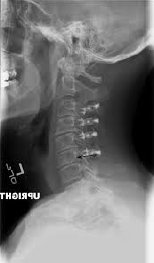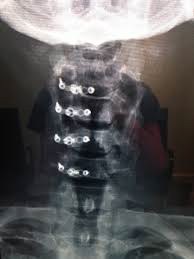Laminoplasty
What is Laminoplasty?
Cervical laminoplasty is a surgical technique that removes pressure from the spinal cord in the neck that can be due to various reasons including degenerative changes, arthritis, bone spurs, disc herniation or fractures. Frequently this spinal cord pressure, called “cervical spinal stenosis”, can occur at multiple levels of the cervical spine at the same time; and if this pressure is severe enough, symptoms of spinal cord damage can develop. The technique is often referred to as an "open door laminoplasty," because the back of the vertebrae is made to swing open like a door.
What are the goals of Laminoplasty?
The goal of laminoplasty in treating “cervical spondylotic myelopathy” is to relieve the narrowing of spinal canal. This procedure immediately relieves pressure by creating more space for the spinal cord and nerve roots. The cervical canal narrowing can result in numbness, pain and weakness of limbs, as well as difficulty in walking and if left untreated, even paralysis. The main goal is to prevent further worsening in neurologic function.
How is Laminoplasty performed?
The laminoplasty procedure involves "hinging" one side of the posterior elements of the spine open relieving pressure on the spinal cord.
First, an incision is made in the back of the neck. Retractors are used to hold the fat and muscle away from the lamina (bone). Instead of removing the bone and other compressive structures, the bone overlying the spinal cord is thinned out on one side with the use of the drill. The other side is cut of the way through with the use of a drill. This creates a hinge on one side of the lamina and a small opening on the other side. The lamina is then hinged open and moved into the “open” position by elevating the lamina on the open side. This vastly increases the space available for the spinal cord and takes the pressure off it. Once this is done, the spinal cord can move away from whatever was compressing it including disc herniation or bone spurs. The bone is held open in the hinged position with the use of metal plates.
Sometimes a drain is left in place and brought through the skin at a separate site to monitor for continued bleeding (this is typically removed the following day). The operation is completed when each layer of the incision is closed with absorbable or non-absorbable suture material (stitches) or surgical staples. If the outer incision is closed with staples or non-absorbable sutures, they will have to be removed after the incision has healed.



What are the risks of Laminoplasty?
There are always risks with any surgery. Potential complications may include:
- Pain, numbness due to nerve manipulation
- Weakness, paralysis due to spinal cord or nerve root damage
- Bowel/bladder incontinence or impotence
- Cerebrospinal fluid leak
- Recurrence or continuation of pain.
- Bleeding/injury to major blood vessels
- Infections
- General anaesthetic complications
What is the success rate?
The success rate of a laminoplasty to alleviate pain from cervical spinal stenosis is generally favourable. The best prediction of a patient’s post-operative outcome is their pre-operative baseline functional level. Some patients may have some improvement in function after the surgery; however, the goal of the surgery is to prevent the worsening of neurologic function or paralysis – not to improve function.
How long will I stay in the hospital?
Each patient heals from surgery differently but generally patients are in the hospital for one to two days following laminoplasty. The main complaint after this kind of surgery is pain in the back of the neck. This pain can be quite severe for several days after surgery, and it then gradually improves over several months. Each individual patient's mobilization (return to normal activity) is largely dependent on his/her pre-operative condition and age. Patients are encouraged to walk directly following a laminoplasty; however, it is recommended that patients avoid excessive bending, lifting or twisting for several weeks after the surgery to avoid breaking the sutures before the wound heals completely. If a drain is placed during surgery this will most likely be removed the following day. Typically, you will be able to go home once your vital signs are stable, you can walk on your own, you can eat without having nausea, and you have resumed normal bladder activity.
What can I expect after I am discharged?
You will be given additional instructions on the day you are discharged which will include:
- Walk daily, gradually increasing time and distance. Avoid sitting or lying down for long periods as this will lead to pain and stiffness.
- Do not get overtired; balance periods of activity with rest periods.
- No driving while taking narcotic pain medication.
- You may go up and downstairs.
- Do not carry heavy items, such as groceries or laundry. Do not lift anything heavier than 3.7 litres of milk until told otherwise by your doctor.
- You should not need special equipment for home













